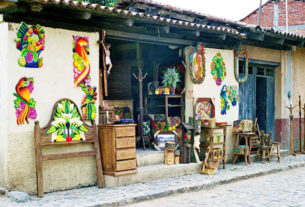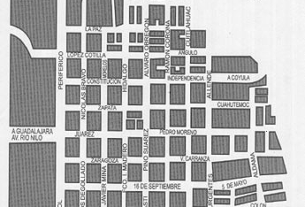Readers of this column often write to inquire about taking cooking classes in Mexico, though I never recommend one that I have not visited personally. This month, another can be added. Casa del Angel, in Cuernavaca, is a cooking school, spa and bed-and-breakfast run by American chef Billy Cross, whose culinary training and experience both in and outside of Mexico is impressive.
Chef Cross studied cooking with Julia Child, Simone Beck and Michael James at their school in the south of France and at the Alliance Francaise in Paris, as well as doing apprenticeships in Roanne and Mougins. He also worked with Alice Waters at Chez Panisse and was a founding director of the Great Chefs of France Cooking School at the Robert Mondavi winery in California’s Napa Valley.
Mexico, however, had held a special place in his heart since a high school visit to the home of a Mexican classmate, and in 1978 he returned to study for a year with Chef Juan Diego Michel in Sayula, Jalisco. Cross then went on to start two more Great Chefs cooking schools, in Puerto Vallarta and Mexico City. He shares his fond memories of cooking with several chefs, home cooks and restaurant owners, including Patricia Quintana and Diana Kennedy, in different parts of the country.
Today Cross runs Casa del Angel, giving cooking classes and market tours, while Joaquin Zagal attends to the spa that is part of the Casa. During the three days I spent at Casa del Angel, I learned some recipes and cooking techniques that I had been looking forward to trying out, including those featured in an article I had read about Billy Cross in Gourmet magazine, which photographed him and his culinary creations against a location background of Oaxacan markets.
Cuernavaca itself is a very convenient place for visitors to Mexico, since it is located just forty-five minutes from Mexico City. Called the “Land of Eternal Spring” because of its nearly perfect year-round climate, Cuernavaca was one of the places Cross visited on that memorable high school trip, and he seems to be right at home there. In fact, he dubs his culinary specialty Regional Homestyle Mexican Cooking.
After a tour of the Cuernavaca market, where he knew every section and each kind of produce, cheese, meat and artesanía available, we returned to the Casa for a cooking class. In that class and a subsequent one, I learned the chef’s secret for perfect fried quesadillas, as well as a Swiss chard filling for tamales with a tomato-herb sauce, a Veracruz-style seafood dish, a pomegranate punch and some refreshing salads and fruit drinks.
Students always get to enjoy the meal they have learned to prepare, which usually includes a first course of a Mexican botana, a soup or salad, main course and dessert. Students may stay at Casa del Angel or come for classes.
On the third day, I was taken on a tour of Tlayacapan, another option offered by Casa del Angel and one which I highly recommend to anyone interested in regional Mexican cooking and beautifully designed pottery at very affordable prices. I was tempted to buy several items, but decided to wait and return with my husband in his truck and fill it up with gifts for family and friends.
Tlayacapan is located northeast of Cuernavaca and we got there in the Casa’s comfortable luxury car in under forty minutes. A pre-Hispanic village and a thriving town today, Tlayacapan boasts a 16th-century convent, a colonial era church, and a couple of old-style bakeries with hornos de bóveda, wood-burning brick ovens. Several small restaurants offer a variety of quesadillas, gorditas and other corn dough-based snacks. One filling I had never had was clales, small bits of chicharrón (fried pork rind), which came in a quesadilla along with nopales and cheese.
After the tour of Tlayacapan, I was happy to return to Casa del Angel, relax in the garden, take a dip in the pool and talk to my host about the regional influences that contribute to his style of cooking.
M.C.: After all the places you have worked and taught in Mexico, why did you choose Cuernavaca for Casa del Angel?
Cross: When I first came to Mexico in 1965 on a bus, the first place I went to was Cocoyoc, where Moctezuma had his winter court. He came for the mineral baths. I fell in love with the Cuernavaca area, its climate and people. (Editor’s Note: Cocoyoc, located twenty-five minutes east of Cuernavaca, is still a well-known hydrotherapy and spa locale. Moctezuma’s father, Aztec emperor Huitzihuitl, married the ruler’s daughter when he conquered Cocoyoc, and Moctezuma, their first born son, returned to his mother’s land frequently to take the waters.)
M.C.: What region has had the most influence on your interpretation of Mexican cooking?
Cross: Because of my life experience, I would say that, after all these years in Mexico, when I want to just go into the kitchen and cook from the “food memory bank” I end up cooking the food of my experiences in Jalisco. When I prepare those dishes, I don’t have to think about it. It’s the first cooking I did in Mexico.
M.C.: What other regions interest you with regard to their special dishes?
Cross: What interests me is home style regional Mexican cooking. I’m fascinated by the way the same dish is interpreted differently in different parts of the country. Even the names of the chiles change. What is called an ancho in other places is called a pasilla here in Cuernavaca. Also, I have to say that I love the food of Veracruz. The rich turkey broth served at the Parroquia, with a Spanish omelet fresh from the pan slipped into the broth and garnished with grilled onions and chiles… that’s Veracruz comfort food. And I’ve just returned from Mexico’s Caribbean coast, where I had the best seafood I’ve ever eaten in my life, spiny lobster grilled over a wood fire. And then there’s the food of Puebla, of Tlaxcala… the home is really the heart of Mexican regional cooking.
Following are some recipes from Casa del Angel that Chef Cross agreed to share with MexConnect readers.
- Tamales de Acelgas con Salsa Verde: Swiss Chard Tamales
- Salsa Verde con Hierbas: Tomatillo Herb Sauce
- Ponche de Granada: Pomegranate Punch


